The First Exhibition of Kung Fu and Chinese Martial Arts in America: Brooklyn, 1890
“A scientific system of fencing with their arms…”
On February 23, 1890, the following announcement appeared in the Brooklyn Daily Eagle:
At Robertson’s Gymnasium, corner of Fulton and Orange streets, on Tuesday evening, Ah Giang and [Foo Jung], champion bantam and featherweight fighters of China, will give an exhibition of the manly art of self defense as conducted in their native country.
Although, previously, a few reports of the existence of Kung Fu and styles of Chinese pugilism had appeared in American newspapers, the exhibition at Robertson’s gymnasium appears to be the first demonstration that was open to the public, and was certainly the first such event that attracted any degree of attention in the American print media. The event, which would take place on Thursday (not Tuesday) evening, February 27, was covered by a number of New York newspapers, including the New York World, the New York Sun, the New York Herald, and the Brooklyn Daily Eagle–the latter displaying the following headline on page 1:
The New York World also included two illustrations (see below) of the Chinese pugilists that took part in the exhibition–images which would be reprinted in newspapers throughout the country. However, these pictures do not match the firsthand descriptions of the combatants’ costumes, and were almost certainly drawn by artists who had no direct connection to the event. Many of the newspaper accounts include language that is derisive and offensive to modern sensibilities. However, even these reports, such as the one that appeared in the Herald, provide useful information, such as the fact that the combatants “fought without gloves and used hands and feet.” The World noted that “Chinese fighting is a mixture of wrestling, boxing, club-swinging, purring [shin kicking] and tumbling…”
“It was said to be the first time that two Chinamen ever gave an exhibition in public in America of the art of self-defence.”
The account that appeared in the Daily Eagle, being both the most respectful and most detailed, will be mostly quoted from here. The description of the event commenced as follows:
“There was a genuine novelty at Robertson’s Boxing Academy, Fulton and Orange streets, last evening, in the shape of a Chinese prize fight. The unique event was sandwiched in between several pugilistic encounters of the usual thoroughbred order, but it was the event, par excellence, of the night, and those who witnessed it saw something they will never forget, although their recollections of the spectacle will not be tinged with any blood curdling reminiscences, but will rather be accompanied by a smile and a sigh of sympathy for the modest advances made by the effete Mongolian civilization in the noble and manly art of self defense. A Chinese prize fight! It sounds well….but they have never been regarded as prize fighters. The two Celestial sluggers who trod the carpet last evening for the edification and delectation of the Caucasian patrons of the P.R. were Ah Giang and Foo Jung, and both were announced to be pugilists of note. Ah Giang is the champion bantam weight of China, and Foo Jung is a member of the Chinese dramatic troupe now in New York City. He is an impersonator of female parts, and in his native land bears an invincible reputation as a fighter, it being related of him that he was never vanquished.
“The science of slugging was as much of a science in China as in America, the difference being that there the aim was always to defend, while here the aim is always to attack.”
Previous to the appearance of the two gentlemen from the Antipodes, a sleek little Chinaman [named Wong Chin Foo], attired in a broadcloth suit, pointed shoes and a Derby hat, and wearing marvelously white cuffs and fine jewelry, stepped into the ring, and made a pleasant speech. He bespoke the respectful attention of the crowd, and informed them that a great surprise was in store for them. The Chinese way of fighting, he said, was no more like the American style than Chinese civilization was like American civilization. In America the sluggers slugged to slug, whereas in the balmy and peaceful land of Joss the sluggers slugged to keep from slugging. But the science of slugging was as much of a science in China as in America, the difference being that there the aim was always to defend, while here the aim is always to attack.”
It is worth noting that the speaker, Wong Chin Foo (1847-1898), was a noted activist for Chinese American civil rights. He was also a former revolutionary, having attempted to overthrow the corrupt Qing government. He fled to the U.S. in 1873, where he established the Chinese Equal Right League, founded a Chinese-language newspaper, crusaded against vice in New York City’s Chinatown, and survived several assassination attempts by gangsters. At one point, he challenged the San Francisco anti-Chinese journalist Denis Kearney to a duel. Wong also bought a Chinese theater, established a language school and opened a Confucian temple.
The Daily Eagle‘s account of the event continued:
“With this explanation the sleck little man in broadcloth stepped out of the ring and took a seat beside Master of Ceremonies McMaster and forth tripped the Chinese fighters, who proved to be two very little men…Both were gorgeously dressed. Foo Jung’s headgear was black and he wore a splendid gold embroidered jacket with black sleeves. Around his waist was a saffron scarf and his pantaloons were white, his stockings gaudily striped in red, white, and yellow, and the top of his sandals were white and the rest of blue silk embroidered in gold. Ah Giang’s headgear was of black and gold, his jacket was plain black in color, and he wore a brilliant red scarf bordered with a broad band of blue. The pantaloons were carmine and the stockings were the same pattern of those worn by his adversary, the sandals being of blue and gold. Being forewarned, the crowd, which was of the ordinary sporting type, numbering in it Police Justice Tighe, paid the strictest attention to the fight, which was announced to be of four rounds of four minutes each, the contestants being classed as light weights…”
Here, the New York World noted that “Two large mattresses were placed on the floor, and as Wong uttered some mysterious word the Chinamen…advanced towards the center of the enclosure. They didn’t think it necessary to put on gloves…”
“The little fighter was lithe, supple as a cat, quick as a flash, furious as a demon, bold as a lion and could jump like a grasshopper and kick like a mule.”
The Daily Eagle continued:
“The defensive tactics of the men were visible from the outset. Foo Jung was smaller than his adversary and had a deep olive skin, large and glittering brown eyes, a long nose and a curling under lip that betrayed his emotions. Ah Giang was taller, broader across the shoulders and longer armed, and his face was square cut, paler and more on the bull dog type…The little fighter was lithe, supple as a cat, quick as a flash, furious as a demon, bold as a lion and could jump like a grasshopper and kick like a mule. The other one was also quick and strong and supple and adroit, and full of courage and expedience. When time was called, instead of capering toward each other the two Chinamen began to slowly circle the ring, with arms crossed at the wrists and palms extended. Only when greatly excited did they clinch their fists and strike blows. They gradually approached each other and then, suddenly, they came together and locked arms and began a scientific system of fencing with their arms. They wrestled with open palms and the little one, seeing his opportunity, inserted his embroidered toe in the folds of his adversary’s jacket and deftly kicked him backward, head over heels. The other fellow jumped up growling and they went at it hammer and tongs, slapping and punching each other and kicking and wrestling, fencing with their arms and jumping around like bewitched automatons. When time was called they promptly returned to their corners and were fanned and seemed to enjoy the attention bestowed upon them.
“He bounded into the air, his eyes gleaming, and came down on his opponent like a load of brick…”
In the second round the same defensive tactics were pursued, but the champion got in a resounding whack with his open palm on the back of his adversary’s neck, bringing forth a grunt of pain and indignation. They darted at each other and slugged and fenced and slapped and made passes at each other, taking care not to actually hit. This is one of the great objects to be attained in a Chinese prize fight. It is not considered an fait to hit, all that is necessary and proper being to make a pass and come so close to an undefended part of the adversary’s body as to make it absolutely certain that the blow could have been there delivered with force if desired. Throughout the fight, unless in the heat of excitement, the Chinamen did not hit with the clenched fist, but lunged and skillfully drew back without hitting. In a Chinese scientific contest for points every blow aimed at a part seen to be undefended and not parried counts for a full score. It is also considered to be proper in China for a fighter to grunt or squeal whenever an unparried blow is aimed at an undefended part, just the same as if he had been actually struck and hurt, and this custom was observed last evening. In the third round the championship cleverly kicked his adversary in the stomach and tumbled him over backward. Then he fell on him, and the other turned him over and got so hot at the thought of the neat way in which he had been upset that he involuntarily sought the champion’s throat, and hand not the sleck little Chinaman with the immaculate cuffs jumped up and sternly ordered them, with a few choice left to right expletives, to desist, it is impossible to say what would have happened. Both jumped up and the fencing was renewed. Once the champion stumbled. This made him mad, and he bounded into the air, his eyes gleaming, and came down on his opponent like a load of brick, and there was a whirlwind of a time for a few seconds and each earnestly slugged the other in orthodox Western Hemisphere style. The last round ended with the champion’s succeeding in again knocking down the larger fighter, and the contest was declared a draw.The crowd relished the sport, but they were pretty generally agreed that it was tame slugging. There was too much delicate science about it, and although the sleek little man was congratulated on all sides for his novel show, the opinion was rife that John L. Sullivan could knock out nine Chinamen in one ring.”
“Although it may seem ridiculous to call such style of fighting scientific, nevertheless it is so considered by all Chinese, who in return stigmatize American boxing as brutal, inhuman and utterly devoid of science or merit.”
In its report of the combat, the Auburn Daily Bulletin stated that “The Chinese boxing rules will allow a man to do everything but bite. The only unfair advantage which can be taken of an opponent is to kick him when down. Everything else goes.” The Bulletin also ended its account by describing the following technique:
“[One] scheme was to drop suddenly on the knees and butt Jung in the stomach. Here the ability of the acrobat was brought into play. Jung jumped over the kneeling form with one bound, at the same time giving Giang a terrific kick in the ribs. This made Giang mad. He kicked, cuffed, punched, and butted the unfortunate Jung unmercifully. Frequently Jung would be obliged to jump over Giang in order to escape punishment, but the wiry athlete was on the lookout, and he would no sooner gain the floor than a kick back of the knee joint would send him rolling over and over. Although it may seem ridiculous to call such style of fighting scientific, nevertheless it is so considered by all Chinese, who in return stigmatize American boxing as brutal, inhuman and utterly devoid of science or merit.”
In the coming days, increasingly sensational reports of the event spread throughout middle America, some going so far as to claim that the contest was no mere exhibition, but an actual duel between bloodthirsty combatants settling an ancient feud. The following headlines, from the Wichita Eagle and the Omaha World Herald, are but a sampling, and give an idea of how a bewildered and excitable American public viewed the arrival of Kung Fu on their shores:
But by far the most important, and historical, statement came from the New York Times, which declared: “It was said to be the first time that two Chinamen ever gave an exhibition in public in America of the art of self-defence.”
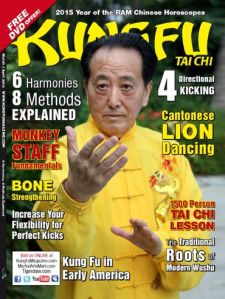 NOTE: A greatly expanded version of this article, covering other Kung Fu contests and practitioners of the same period, and with accompanying photographs, appears in the 2015 March/April issue of Kung Fu Magazine, under the title Kung Fu in Early America.
NOTE: A greatly expanded version of this article, covering other Kung Fu contests and practitioners of the same period, and with accompanying photographs, appears in the 2015 March/April issue of Kung Fu Magazine, under the title Kung Fu in Early America.
Trackbacks & Pingbacks
- American reports of Kung Fu eye-gouging contests in 1891 | Martial Arts New York
- Kung Fu Tea Selects the Top Chinese Martial Arts Webpage of 2014 | Kung Fu Tea
- Singlestick and Kung Fu: The U.S. Navy Encounters “Chinese Kicking” in 1895 | Martial Arts New York
- Vivid Report of Chinese “Gladiators” Reaches New York in 1891 | Martial Arts New York
- First Report of a Bare-Knuckle Kung Fu Contest in New York City’s Chinatown, 1891 | Martial Arts New York
- First News of Kung Fu Arrives in America, 1830 | Martial Arts New York
- Western Perceptions of Chinese Martial Arts | Zhongguo Wu Xue

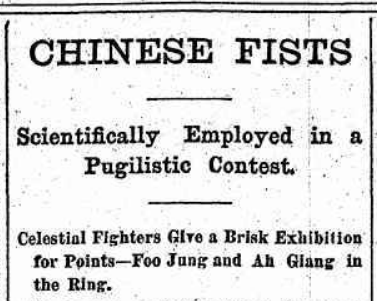
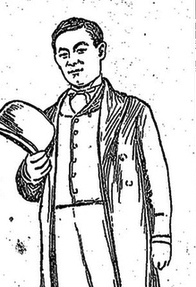
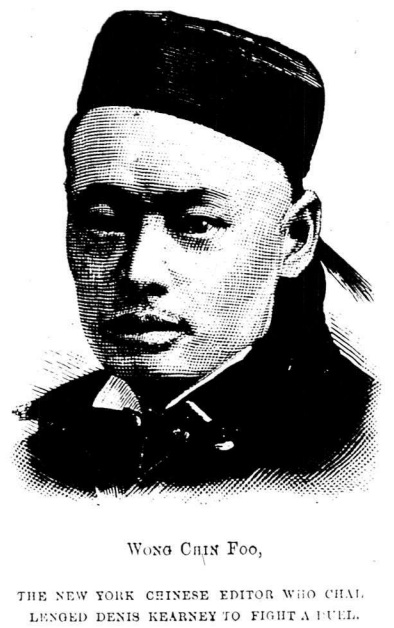
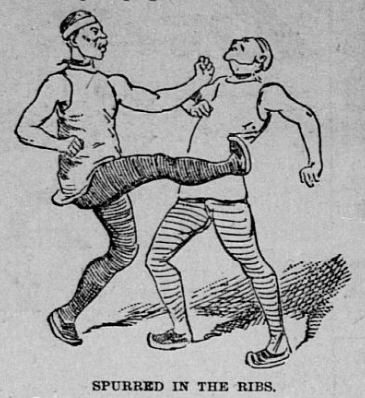
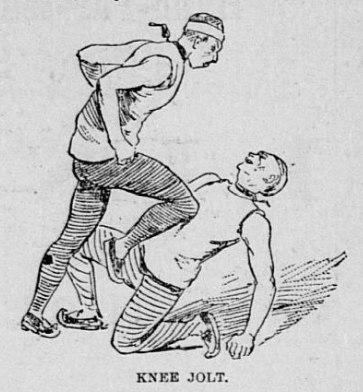
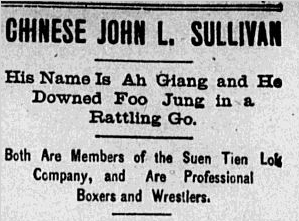


Thank you so much for this gimps into history. Great Job!
LikeLike
Thanks, Jason! I’ll keep them coming…
LikeLike
That was cool to read. Thanks for posting!
LikeLike
Awesome find!
LikeLike